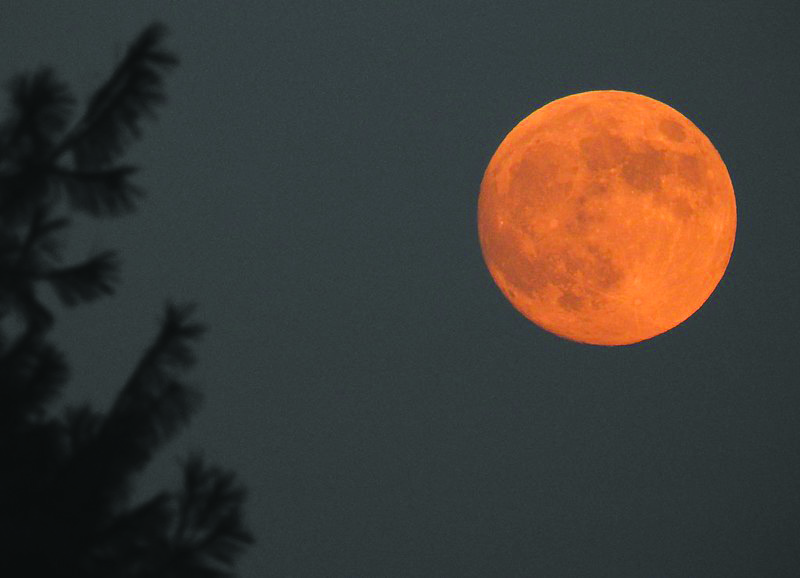Ask an Expert: Moon Names
I’ve heard full moons referred to as Harvest Moon, Hunter’s Moon, and others – where do these names come from and what do they signify?
Jack in Frostburg
Nicknames for full moons have an ancient history, and it is closely tied to the cycle of natural resources. In North America, native tribes and later early European settlers identified full moons by important happenings or activities related to hunting, fishing and agriculture. This was obviously important knowledge to societies that quite literally lived and died by knowing how to work with nature.
Every local society had its own unique names for the moons – depending for example if the people lived in the mountains or on the coastline. Settlers also merged these names with their own Julian and Gregorian calendars, so the months don’t always correspond exactly with the moons that fall on a 28-day cycle. But what follows is a generally accepted list from sources as diverse as NASA and old Farmer’s Almanac:
January — Wolf Moon
For much of North America, wolves howled more often at this time, most likely due to scarce hunting in the winter months. While wolves have long been extirpated from Maryland, they were plentiful enough in colonial times for officials to offer bounties to hunt them, well into the 1800s.
February –Snow Moon
February’s reputation as the snowiest month was keenly observed by the ancients, and also by NOAA records that show a monthly snowfall norm of 8 inches. Twice, in 1899 and in 1979, February snow in the Baltimore area exceeded 33 inches. That much snow probably even muffled the sounds of the howling wolves!
March — Worm Moon
Winter thaws bring soft ground and the movement from earthworms, also attracting the attention of more active birds like the first robin of spring. Another name for this moon was the Sap Moon, marking the time of tapping maple trees — and perfectly timed with the annual Maple Syrup Festival at Cunningham Falls State Park!
April — Pink Moon/Fish Moon
Pink Moon referred to the sudden spread of the wildflower ground phlox, still a common native plant popular with gardners using more native and wildflower varieties. Along the coasts and rivers, it’s likely this moon would have been called its alternative name Fish Moon, as shad came upstream to spawn. Catching them was probably much easier with all the worms that started moving last month.
May – Flower Moon
You guessed it — more flowers (April showers brought them, you know.) It was also called the Corn Planting Moon, but in general this moon marks the full arrival of growing season, when the landscape from ground to treetop is in full bloom.
June — Strawberry Moon
It’s still the best time of the year to harvest and eat farm-grown strawberries. Maryland’s hunter-gatherer population would have also found wild strawberries abundant in the forests with peak ripeness right about the time of this first summer moon. Although not official, we might also call it the Horseshoe Crab moon, because this full moon is the peak of when that prehistoric arthropod comes ashore to spawn. But they go terribly with shortcake.
July — Buck Moon
This name refers to the new velvet-like antlers emerging on young buck deer — and undoubtedly Maryland’s early hunters began taking note of the buck population in the nearby woods, gearing up for the hunting them later in the year.
August — Sturgeon Moon
This moon marks when this huge fish of the Great Lakes and other major bodies of water were most ready to be caught. Atlantic Sturgeon were also plentiful on the East Coast until depleted for the caviar market early in the 20th century. But they’ve been making a comeback, with spawning adults found in Maryland rivers for the first time in decades.
September — Harvest Moon
Probably the most famous of the moon nicknames, it’s given to the full moon closest the autumnal equinox — usually in September but sometimes in October. Tradition says that farmers could gather their harvest late into the night by this moon’s light. Interestingly, for the few nights around the Harvest Moon, the moon seems to rise at nearly the same time each night, making planning that much easier.
October — Hunter’s Moon
The deer are well fed (and those bucks we saw in July are getting larger); fields are reaped for clearer viewing; the ground is covered in leaves, giving away the sounds of the hunter’s quarry — the time is now to harvest meat for the winter.
November — Beaver Moon
For tribes and settlers, this would be the time to set beaver traps before the swamps freeze to ensure a supply of warm winter furs. Today, Maryland’s beaver trapping season begins at the end of November in Western Maryland and mid-December everywhere else – so regardless of the moon, make sure you check your Maryland and Hunting Trapping Guide!
December — Cold Moon, or Long Nights Moon
This moon usually occurs near the winter solstice, the longest night of the year, and the beginning of the cold season. This is when the stocks of the year’s harvests would be used to survive until the wolves and snows of winter would pass, and the worms of spring would signal new life again!
Gregg Bortz
Media Relations Manager, Office of Communications
Appears in Vol. 22, No. 4 of the Maryland Natural Resource magazine, fall 2019.



 1-888-373-7888
1-888-373-7888 233733
233733